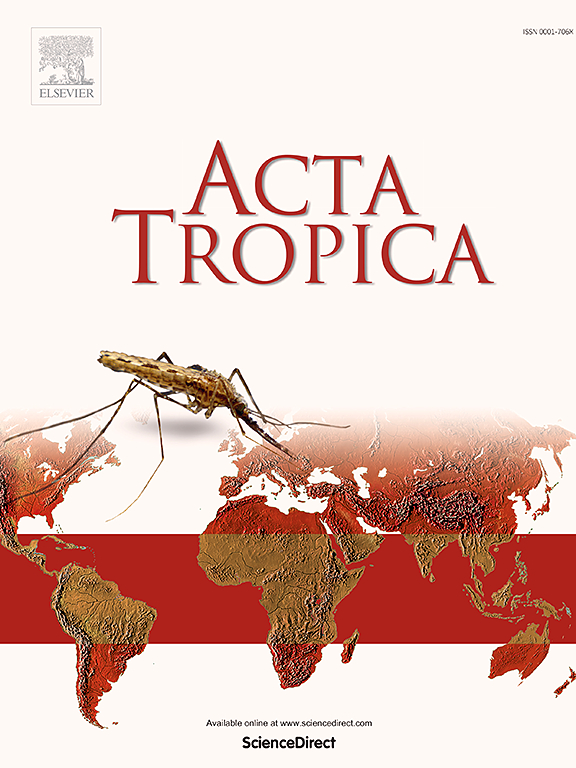Evaluation of Wolbachia infection in Aedes aegypti suggests low prevalence and highly heterogeneous distribution in Medellín, Colombia
IF 2.1
3区 医学
Q2 PARASITOLOGY
引用次数: 0
Abstract
Dengue virus, transmitted mainly by Aedes aegypti mosquitoes, is a significant public health challenge in tropical and subtropical countries, with an incidence that is growing at an alarming rate. The release of Wolbachia-carrying mosquitoes has been suggested as a strategy to reduce the incidence of multiple arboviruses. In Medellín, Colombia, large-scale releases of Wolbachia-infected Ae. aegypti mosquitoes were performed between 2017 and 2022 by the World Mosquito Program to facilitate population replacement. In this study, we evaluated the prevalence and distribution of Wolbachia-infected Ae. aegypti two years after completion of these releases. We conducted the sampling across 19 communes in Medellín, using 416 ovitraps to collect Ae. aegypti eggs from epidemiological weeks 26 to 41 in 2023. Upon hatching the collected eggs, we identified and pooled adult female Ae. aegypti for DNA extraction. Subsequently, we conducted PCR assays for the detection of Wolbachia infection in these mosquitoes. We used maximum likelihood estimation (MLE) and Bayesian methods to estimate the prevalence of Wolbachia infection, while using QGIS to analyze spatial distribution of infection in the region. A total of 774 female Ae. aegypti mosquitoes from 182 pools were evaluated. We detected Wolbachia in 33.5 % of pools, with an estimated individual minimum infection rate of 9.5 % and a maximum of 33.2 %. The prevalence varied significantly across communes, with the highest rates observed in the northeastern and southwestern areas. Spatial analysis revealed a highly heterogeneous island-like distribution of Wolbachia across Medellín with a few hotspots. The observed Wolbachia prevalence in this work was lower than previously reported. We suspect a decline in the prevalence of Wolbachia-infected Ae. aegypti mosquitoes in Medellín following the completion of their release.
对埃及伊蚊沃尔巴克氏体感染的评估表明,在哥伦比亚麦德林,沃尔巴克氏体感染率较低,且分布高度不均。
登革热病毒主要由埃及伊蚊传播,是热带和亚热带国家面临的一项重大公共卫生挑战,其发病率正以惊人的速度增长。有人建议将释放携带沃尔巴克氏体的蚊子作为降低多种虫媒病毒发病率的一种策略。在哥伦比亚麦德林,世界蚊子计划在2017年至2022年期间大规模释放了感染了沃尔巴克氏体的埃及疟蚊,以促进种群替换。在这项研究中,我们评估了这些释放完成两年后受沃尔巴乔病毒感染的埃及伊蚊的流行率和分布情况。我们在麦德林市的 19 个社区进行了采样,使用 416 个卵盘收集 2023 年流行病学第 26 周至第 41 周的埃及蚁卵。收集到的卵孵化后,我们对成年雌性埃及蚁进行了鉴定和集中,以提取 DNA。随后,我们用 PCR 方法检测这些蚊子是否感染了沃尔巴克氏体。我们使用最大似然估计法(MLE)和贝叶斯法来估计沃尔巴克氏体的感染率,同时使用QGIS来分析感染在该地区的空间分布。共对来自 182 个水池的 774 只埃及雌蚊进行了评估。我们在 33.5% 的水池中检测到了沃尔巴克氏菌,估计个体最低感染率为 9.5%,最高感染率为 33.2%。各乡镇的感染率差异很大,东北部和西南部地区的感染率最高。空间分析表明,整个麦德林的沃尔巴克氏体分布非常不均匀,呈岛屿状分布,只有少数几个热点地区。这项工作中观察到的沃尔巴克氏菌流行率低于之前的报告。我们怀疑在埃及姬蚊释放结束后,麦德林受沃尔巴克氏体感染的蚊子的流行率会下降。
本文章由计算机程序翻译,如有差异,请以英文原文为准。
求助全文
约1分钟内获得全文
求助全文
来源期刊

Acta tropica
医学-寄生虫学
CiteScore
5.40
自引率
11.10%
发文量
383
审稿时长
37 days
期刊介绍:
Acta Tropica, is an international journal on infectious diseases that covers public health sciences and biomedical research with particular emphasis on topics relevant to human and animal health in the tropics and the subtropics.
 求助内容:
求助内容: 应助结果提醒方式:
应助结果提醒方式:


